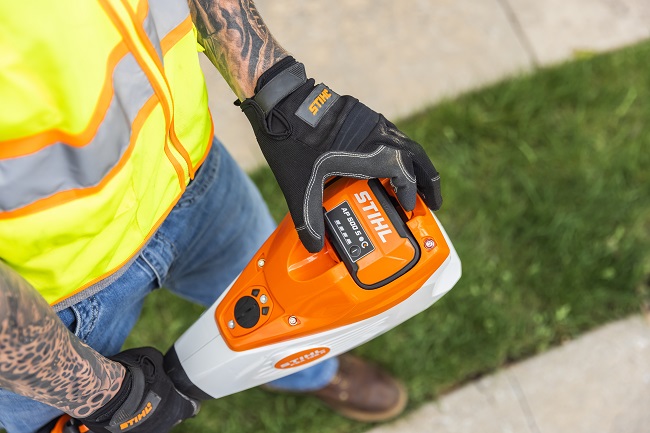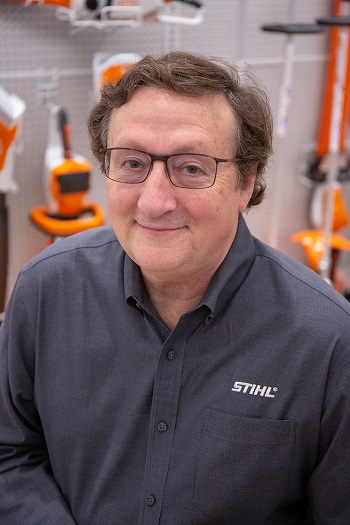Fully Charged: Why Battery Products are Worth Consideration
By Steve Wilcox
It seems like the outdoor power equipment industry’s vocabulary has changed almost overnight. What was once a conversation consumed by gasoline or petroleum has now turned to a discussion revolving around battery and lithium-ion technology.
For those professionals and homeowners who have spent their life in a gas world, there’s some adjustment in learning how battery-powered outdoor power equipment can benefit your customers and their businesses—but it’s worth the effort.
False perceptions abound when it comes to battery-powered equipment, especially in reference to how it compares to gasoline counterparts. Some of the common misconceptions that get tossed around include battery isn’t powerful enough, that it doesn’t deliver the necessary run-time, that the products are too expensive and that the need to change operations to adapt to battery technology is still a long way off into the future. However, the truth is, battery-powered tools are quiet, no longer have memory issues, are often power-equivalent to gas products, and have the advantage of zero-exhaust emissions.
Not just for homeowners
When professionals come in looking for new fleet, it’s crucial to consider a modular battery platform that will drive several OPE professional tools. Encourage customers to look for a broad assortment that extends from trimmers and blowers to multi-attachment tools and ensure they’re getting a professional-grade tool. Does the platform being considered have a line of equivalent gas products and do components from the gas products transfer to the battery tools?
I also suggest not starting from zero with a brand that’s unproven to your customer base. Some brands will carry over the specifications and technology they’ve created from decades on the gas side to their battery equipment. The advantage is in tool balance, maneuverability and weight – all critical factors for tools that may be used daily.
The advantages of battery tools as a category also extend to maintenance. Many professional-grade battery-powered tools come equipped with a brushless motor, which is virtually maintenance-free. The battery-powered Ni-Cad tool your dad used had an electric motor with brushes that had to be changed periodically. That’s not the case today. With battery, there’s no need to buy, transport or store fuel, and that means no requirement to mix oil and gasoline or have concerns about long-stored fuel that might deteriorate. Finally, there’s no tune-up for an electric motor and no need to winterize.
Real advantages
Many battery-powered tools are quieter and can be used by professionals upkeeping schools, colleges, corporate customers and other municipalities who are demanding the use of electric tools by landscaping professionals. Some tools are even quiet enough to use without hearing protection. On top of all that, battery-powered OPE tools are easy to start – no choke, no starter rope – simply turn the tool on or off.
Another point of differentiation is vibration. Battery-powered tools with an electric motor create less vibration for the user, providing comfort and reducing fatigue. This is another element in looking at the overall advantages and return on investment that lithium-ion battery-powered tools can potentially deliver.
Playing the power game
It all comes down to power for many professional landscapers, but how do you assure your customers that they’re getting an apples-to-apples comparison? The answer is watt-hours.
Here’s how it works: Most manufacturers post the voltage of their platform on the packaging – generally in big numbers or letters. And it’s great to know the voltage of the system, but that doesn’t tell you anything about the overall power of that tool. To calculate the watt-hours of a battery tool, you simply use the equation: volts x amps = watt-hours. The watt-hours tell you what the output of the tool is.
So, if you have an 80-volt system and a 2 Ah battery, you’re looking at 160 watt-hours. But if you have a 36-volt system and a 5 Ah battery, the output is actually higher, at 180 watt-hours. Watts hours can be a great way to knowing exactly what tool will be the most fitting the product for your customer’s project at hand.
There are also some not-so-obvious functions to be aware of in comparing tools and systems. A big one is the battery management system (BMS). The BMS allows the tool to “talk” to the battery and the charger. That conversation is all about monitoring individual cells to ensure consistent power and to protect the system from overload, tool overheating and deep battery discharge (an energy level that slows the full capability of the battery). Of course, not every OPE tool offers a battery management system and some tools offer a battery management system that performs some system-protection functions but not all. Many professional landscapers are concerned about up-time, so reassure them with a product with a full-capability BMS designed to deliver maximum uptime.
The years ahead
With more municipalities, counties and government agencies requiring battery-powered tools or outright banning the use of gas equipment, the time is now to start learning about how lithium-ion batteries and equipment can become a part of your customer’s fleet.
Maybe the customers you have today don’t demand these tools, maybe they won’t in two years, but at some point, in the near future, they’ll have to confront the need to have battery power in their mix. The funny part is that despite the reluctancy to battery, it’s actually beneficial for professional and homeowners to have battery-powered tools. These tools are environmentally sound (you’re in the green industry), require less maintenance, save your customers money and provide them an ease-of-use. The technology behind battery-powered tools only promises to get better and more capable over the years ahead.
Steve Wilcox, is battery communications manager for Stihl Inc. This article first appeared in our May/June 2022 issue.



